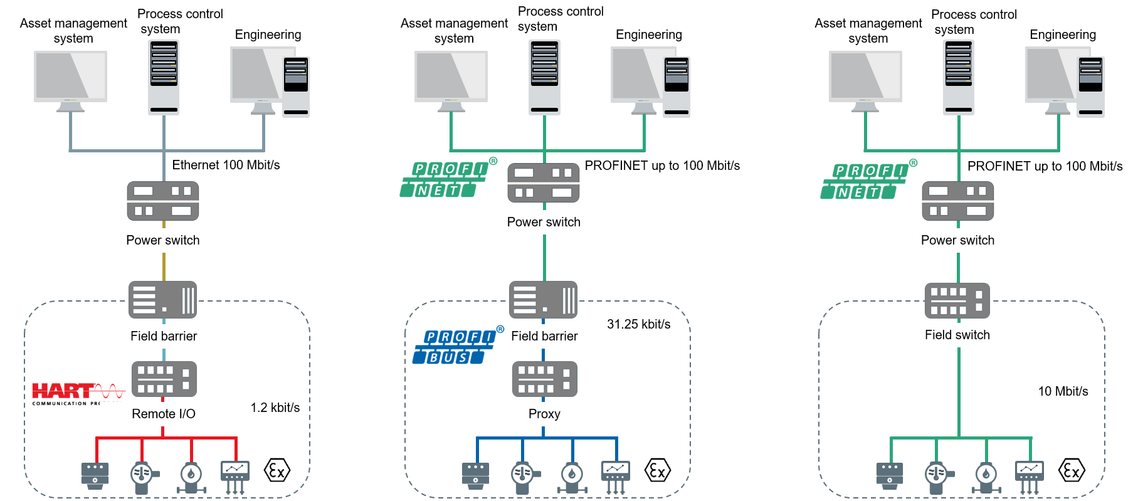Advanced Physical Layer (APL): Ethernet en campo

La tecnología Ethernet-APL está revolucionando las posibilidades de transmisión de datos en la industria de procesos, ya que por primera vez es posible comunicarse directamente a nivel de campo a una velocidad de hasta 10 Mbit/s y con un protocolo homogéneo. La tecnología de capa física avanzada (APL) permite suministrar energía y señales de comunicación a través de instalaciones convencionales de dos hilos y es adecuada para su uso en zonas con peligro de explosión.
Desarrollo de un nuevo estándar de comunicación
Desde la fundación del consorcio APL en 2018, SAMSON ha participado en el desarrollo de la tecnología como socio industrial y miembro activo del comité. Por primera vez en la historia de la industria de procesos las principales organizaciones de estandarización, FieldComm Group, OPC Foundation, ODVA y PI (PROFIBUS & PROFINET International), así como doce fabricantes de renombre de sistemas de control de procesos, tecnología de infraestructura y dispositivos de campo, trabajaron juntos en un proyecto. En 2016 SAMSON presentó el primer prototipo APL en la feria Valve World, que todavía hoy se exhibe en nuestro laboratorio digital ROLF SANDVOSS INNOVATION CENTER en Frankfurt y se utiliza para fines de prueba. El lanzamiento oficial de la nueva tecnología Ethernet-APL tuvo lugar durante la feria virtual ACHEMA en 2021.

Tecnología
La capa física avanzada (APL) define la capa de transmisión física que permite una comunicación Ethernet homogénea directamente en el nivel de campo y en zonas con peligro de explosión. Pueden utilizarse cables de bus de campo convencionales de Tipo A según norma IEC 61158-2. La tecnología de conexión de dos hilos es apta para zonas intrínsecamente seguras, está protegida contra inversión de polaridad y permite la comunicación a 10 Mbit/s, así como la alimentación eléctrica a través del mismo cable.
Ethernet-APL es compatible con los protocolos basados en Ethernet más usuales, como EtherNet/IP™, HART-IP™, OPC UA y PROFINET®, lo que ha sido posible gracias a la colaboración de las cuatro principales organizaciones de normalización (FCG, ODVA, OPCF, PI). Una gran ventaja del "Ethernet en campo" es el uso de un protocolo homogéneo a todos los niveles, lo que permite prescindir por completo de los convertidores de protocolos en la arquitectura de la planta. Esto ayuda a simplificar la arquitectura de red.
Beneficios
En 2021, tras solo tres años de trabajo conjunto en el consorcio APL, se pudo presentar la tecnología Ethernet APL en la feria ACHEMA Pulse. Las ventajas de esta nueva tecnología incluyen la comunicación de extremo a extremo hasta el nivel de campo, una menor complejidad de la infraestructura y una velocidad de transmisión de datos de 10 Mbit/s para transferir datos de procesos y dispositivos utilizando instalaciones convencionales de dos hilos. También puede utilizarse en zonas intrínsecamente seguras (2-WISE: 2-Wire Intrinsecally Safe Ethernet). Permite la comunicación a distancias de hasta 1.200 m. Prácticamente se puede acceder a los datos en tiempo real gracias a la comunicación en todos los niveles de la planta y a la alta velocidad de transmisión de datos.
Las funciones implementadas en el perfil PROFINET 4.0 facilitan la puesta en marcha, ya que reducen el esfuerzo de configuración e instalación de la red. La tecnología Ethernet-APL implica un alto grado de estandarización y se basa en la definición precisa de los componentes. Esto simplifica considerablemente la búsqueda de componentes adecuados dentro de una planta.
La alta velocidad de transmisión de datos de 10 Mbit/s permite una conexión casi "en directo" hasta el nivel de campo. De esta forma se consigue una perspectiva completa del sistema y se pueden tomar las decisiones correctas. La comunicación estandarizada de alta velocidad a todos los niveles permite acceder al estado general de la planta en tiempo real. El acceso rápido y directo a los datos de dispositivos, procesos y diagnóstico asegura la detección precoz de anomalías y permite una intervención proactiva, antes de que aparezcan averías en los equipos.
Nuestro posicionador compatible con APL
TROVIS 3797

El posicionador TROVIS 3797 con comunicación PROFINET® es el primer posicionador de SAMSON compatible con la nueva tecnología Ethernet-APL. Este posicionador se basa en la plataforma de posicionadores de alta gama de la Serie 379X. Mediante módulos opcionales, se puede ampliar la capacidad de aire y adaptarlo a accionamientos de simple y doble efecto. La adición de sensores de presión opcionales mejora las capacidades del probado diagnóstico de válvulas totalmente integrado para garantizar un funcionamiento seguro y fiable.
Temas relacionados
SAM LAN
Válvula piloto
Válvula de escape rápido
SIL
Media
Válvulas lineales
Sede central
Digitalización
SAM GUARD
Formación
Consejo de Supervisión
Filiales
Final de carrera
Medidor de presión diferencial
Posicionador
Careers
Conference
Configuraciones
Electroválvulas
Compromiso
Service
Válvulas de control
Oficinas de ventas
Accesorios
Automatización
Hydrogen
Sistemas de automatización
Válvulas
Seminarios
Consejo de Administración
Reguladores de presión de alimentación
Industria 4.0
MainChange
SAM TANK MANAGEMENT
Reguladores sin energía auxiliar
Accionamientos
Relé de bloqueo
SAM DIGITAL
FDI
Amplificador de caudal
SAM DISTRICT ENERGY


